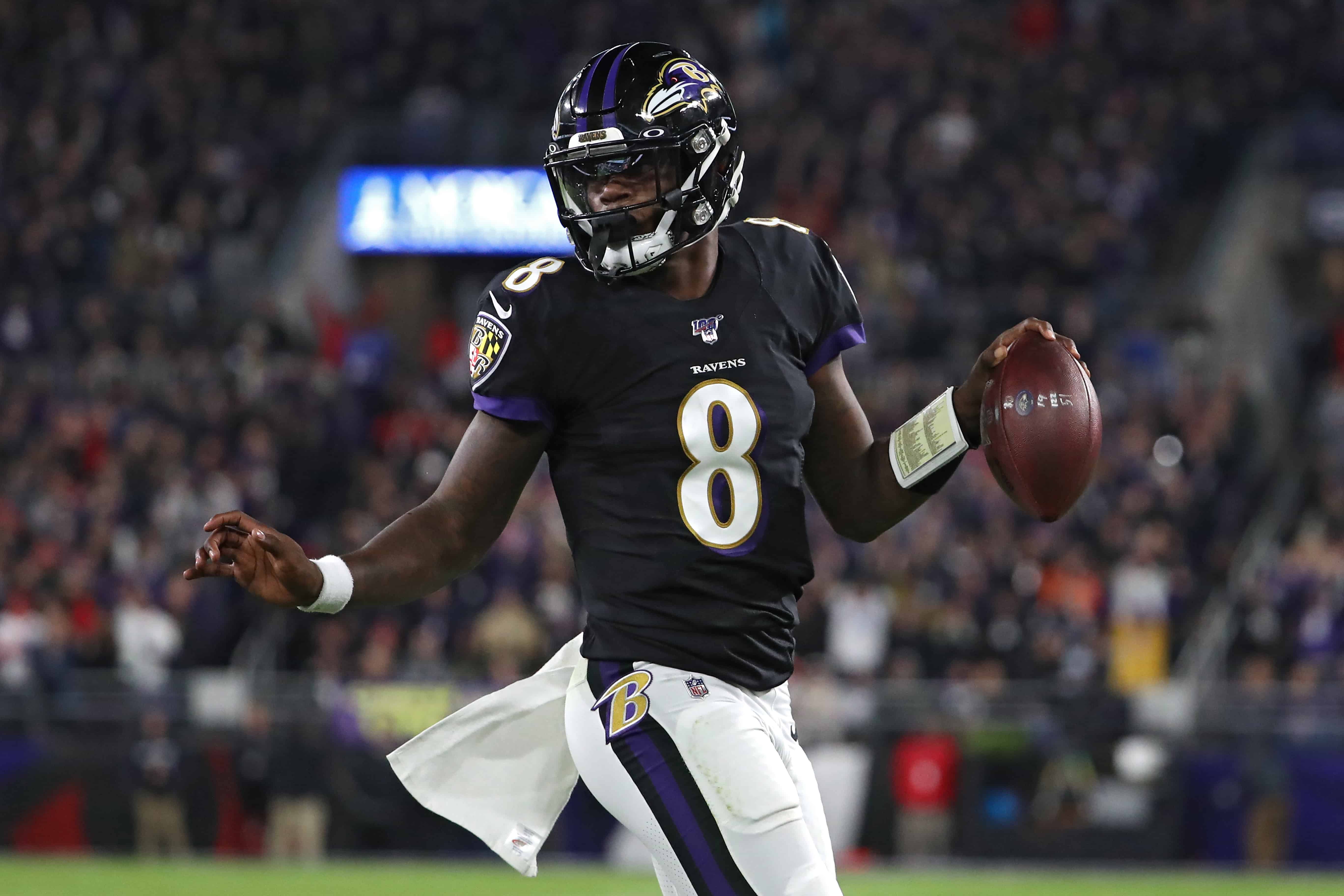Looking for detailed insights about the Baltimore Ravens players, coaches, and philosophies?
This chapter from Warren Sharp’s ‘2020 Football Preview' book gets you prepared for the NFL season by delivering the smartest information & analysis in the fastest, most direct way possible.

I don’t think many people were as high on Lamar Jackson coming out of Louisville as I was. I was hoping he would fall to the Ravens at No. 25. He did, but they did their market research and predicted they would still be able to land him at the end of the first round.
In the summer of 2018, the Ravens were trying to figure out how to sell tickets and prevent no-shows at the stadium. The newspapers literally read: “Ravens trying to win back fans, while trying to win again,” to which my response at the time was four words: “Just start Lamar Jackson”.
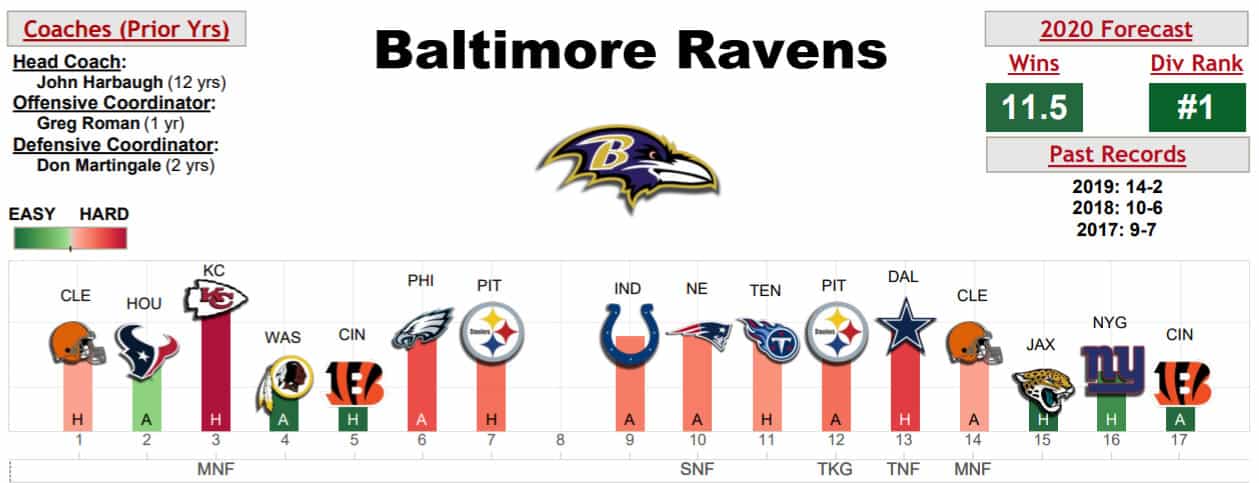
The summer of 2019 was a bit brighter in Baltimore, but many people still couldn’t forget the way they lost to the Chargers in the 2018 playoffs. They also couldn’t forget how Jackson didn’t look the part of a prototypical quarterback. The Ravens were projected to win only 8.5 games and finish in third place in the AFC North.
I couldn’t believe it. My opinion was completely different from the public.
Not only did we take the Ravens to win the AFC North and their win total over 8.5, but some exposure to Lamar to win MVP in our corner as well. And while many were worried about the way the Ravens ended the season, I believed it would catapult them for a dominant run in 2019.
Jackson set so many marks it’s hard to count them all, but some of the most intriguing ones:
- First player to pass for 3,000 yards and run for 1,000 yards in a season
- First player to throw for 30 TDs and rush for 1,000 yards in a season
- First player to pass for 3,000 yards and run for 1,500 yards in his first two seasons
- Youngest quarterback to achieve a perfect passer rating
And there are countless others.
Being right on Lamar Jackson was extremely fun, but Jackson was not the only reason the Ravens were dominant.
Two of the most overwhelming reasons for the Ravens success:
First: organizational buy-in to the analytics movement. Second: commitment from the coaching staff, particularly John Harbaugh and Greg Roman, to build entirely around Jackson’s unique talents.
The Ravens became the most aggressive offense in the NFL on fourth downs. That’s the low-hanging fruit. One of the other things that goes less discussed is the race to a halftime lead. It’s a principle I’ve preached for several years now. The correlation of a halftime lead with winning the game is extremely strong (simple enough) but there are fundamental reasons why teams with a halftime lead tend to win more often.
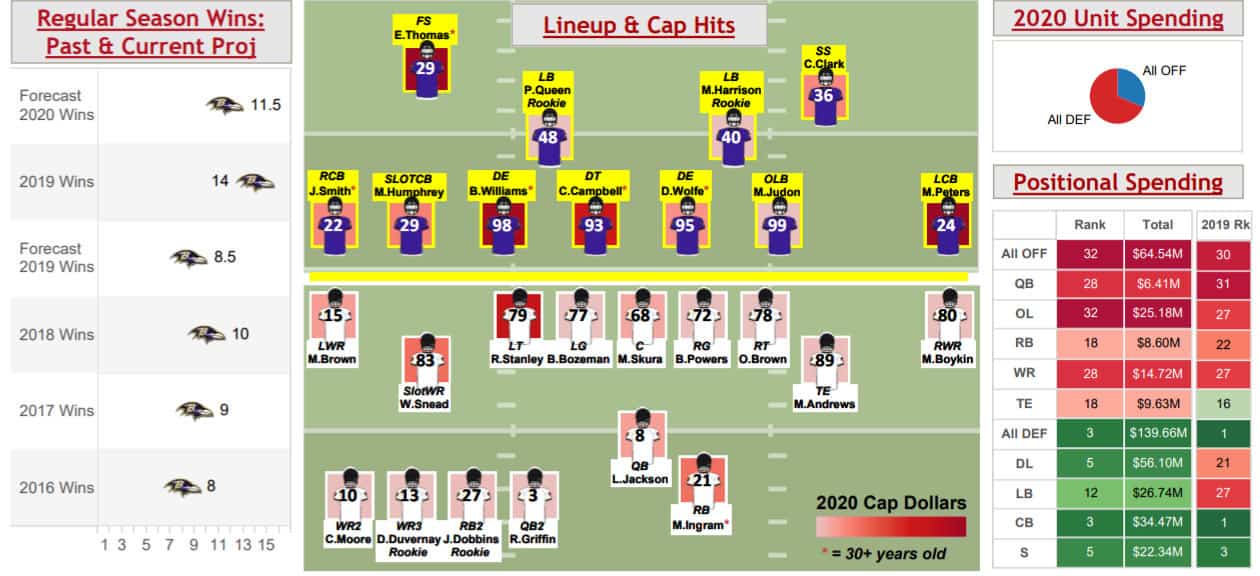
Opposing offenses often will make halftime adjustments to become more desperate in the second half and shift away from their most efficient path to victory. Forcing that upon an opponent is a desired objective.
Here is the irony. What do coaches preach, from high school to the NFL? Turnovers lose games. We must protect the ball and not give it away. And they aren’t wrong. Teams that won the turnover battle won 78% of games since 2010. Virtually all NFL coaches preach this message and drive it into the behavior of their players.
But you know what other statistic wins games at the EXACT same rate? Leading at halftime.
Teams leading at halftime won 78% of games since 2010. Identical to winning the turnover battle.
Do you hear any coach preaching first half aggressiveness in order to build a lead at halftime?
The answer had been no, at least as far as I heard. Having spoken with several teams in the league in a consulting capacity, there are now a few coaches who have heard this message and may publicly talk about a goal of building a halftime lead. But this is new and is still very infrequent.
In the first half of games, the Ravens were exceedingly aggressive. In the first half, an astounding 41% of their drives resulted in a touchdown.
For the complete Baltimore Ravens chapter, including a dozen more visuals & info-graphics, Defensive breakdown and detailed Fantasy football implication — plus the other 31 team chapters — pick up a copy of Warren Sharp’s new ‘2020 Football Preview’ book and use the coupon code “BOOK10” to take $10 off at purchase.
While the offense of the Kansas City Chiefs is incredible, they scored touchdowns on 33% of their first half drives. The NFL average was 21%. For more context: the blitzkrieg offense of the 2016 Falcons scored TDs on 33% of their first half drives. Not since the Tom Brady-Randy Moss-Wes Welker record-setting 2007 Patriots had an offense been as potent in the first half… and what type of weaponry did Lamar Jackson have to work with?
Jackson had two players targeted 50+ times: a rookie WR who started the season injured and was in and out of the lineup frequently due to injury and a second-year TE who entered the season with 34 career receptions.
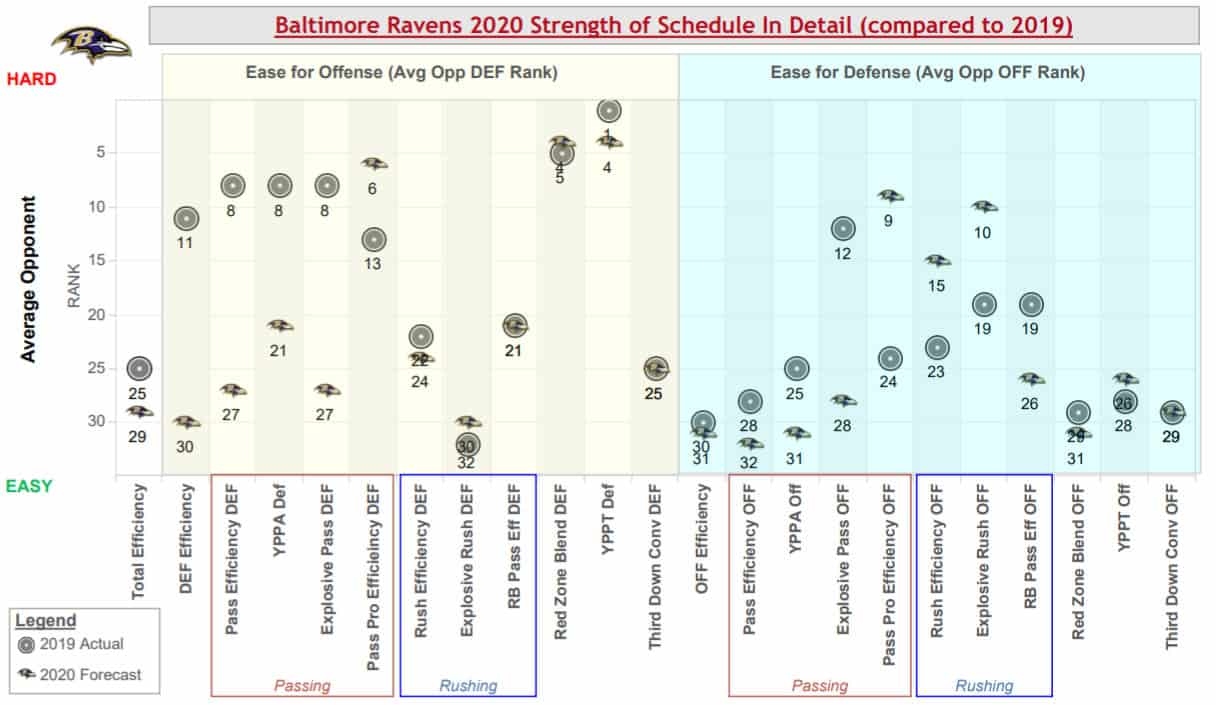
The fact the offense was as productive and efficient in scoring these touchdowns was fundamentally thanks to it’s proficient and extraordinarily diverse rushing attack.
Looking at full season stats skew things with the Ravens offense because they led by multiple scores on average at halftime. As such, they used heavier groupings late and simultaneously went less creative with the offense in general.
Just isolating the first half of games, the Ravens possessed the NFL’s
- best rushing offense from 11 personnel
- best rushing offense from 12 personnel
- second-best rushing offense from 21 personnel
- third-best rushing offense from 22 personnel
and the Ravens were the only team with at least 40 attempts from each of those groupings in the first half. That’s diversity in attack while being extremely strong at the same time.
In the first half of games, the Ravens averaged 6.9 YPC when running from 11 personnel.
Incredibly, that was a higher yards per play average than the NFL yards per attempt (6.7) when offenses threw the ball in the first half from 11 personnel.
There is a huge value in the mantra I wrote in these pages of the 2019 Ravens preview last summer: “do something different and do it well.” There is such a huge edge in zagging while the rest of the NFL zigs. It becomes very difficult for opponents to prepare in under a week for your unique style.
In the first half of games, the Ravens primarily ran QB designed runs, inside zone and Power, but they sprinkled in stretch, lead, duo, and outside zone as well. They gained an absurd 8.2 YPC on outside zone runs and when Jackson carried the ball, he recorded a 67% success rate whether running by design or scrambling due to coverage, and his YPC was between 6.9 YPC and 8.3. The rushing offense averaged the most YPC in the entire Super Bowl era.
Interestingly, in the Ravens’ playoff loss last year, a self-inflicted reason that contributed to the loss (aside from flat out bad luck with fourth down conversion rate variance) was not running the ball enough.
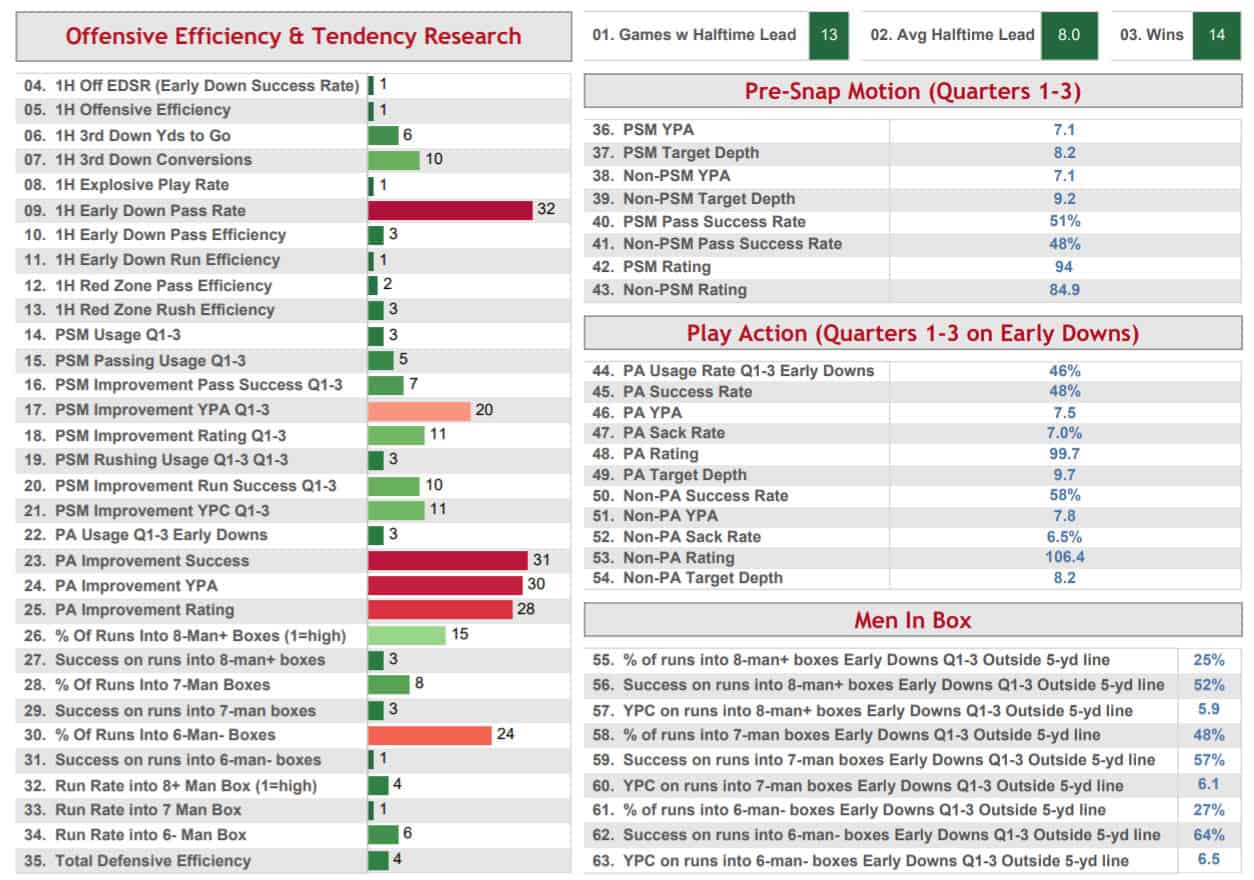
Weeks 1-16, opposing defenses typically kept seven men in the box on 50% of the Ravens’ early down plays in the first three quarters (NFL average was 44%). On only 27% of runs did defenses have 6 or fewer men in the box against the Ravens’ rushing offense (NFL average was 33%).
There were some games defenses played the Ravens differently. Week 3 vs KC, Week 4 vs the Browns, Week 5 vs Pittsburgh, Week 12 vs the Rams, Week 13 vs the 49ers, and Week 15 vs the Jets were six games where opposing defenses kept six or fewer defenders in the box on at least 30% of the Ravens’ offensive snaps. The Ravens made them pay. They ran the ball on 55% of their snaps when facing boxes of six or fewer and averaged 7.2 YPA with a 72% success rate.
But in the playoffs, things were different. The Titans put six or fewer defenders in the box on 45% of early downs through three quarters. Well above average. And yet the Ravens did not make them pay.
Against six or fewer box defenders, the Ravens ran the ball just 28% of the time. These runs gained a staggering 8.0 YPC and a 67% success rate. But they passed the ball 72% of the time. And with few box defenders and extra men in coverage, the Ravens’ passing attack struggled. Jackson went 11/23 for just 4.2 YPA. He recorded a 57 passer rating and just a 45% success rate.
Even if you exclude all QB runs: against defenses that chose to use six or fewer box defenders at least 25% of the time, the Ravens had run the ball 40% of the time for 5.8 YPC and a 67% success rate on the season. But against the Titans in the playoffs, they ran just 12% of the time, despite averaging 8.0 YPC and a 67% success rate.
Last season in divisional rematch games, every single defense opted to go with heavier boxes (PIT from 35% six-man boxes to 10%, CIN from 33% to 22% and CLE from 33% to 8%) to try and slow down the run. So it’s unlikely teams the Ravens face in 2020 will think that lightening the box is the way to beat the Ravens. But for the Titans, it worked primarily because the Ravens allowed it to work.
The two areas the Ravens offense could improve to dominate even further relate to reacting to the defense. And putting themselves ahead of the game even further.
First is allowing Jackson the ability to audible further and check to runs more frequently based on box counts. The Ravens ran the ball (including QB runs) against six or fewer men boxes on 41% of early down plays in the first three quarters. The NFL average was 41%, but six teams had an even higher run rate (Seattle’s 46%, Buffalo’s 45%, Oakland’s 44%, Indy’s 42%, Detroit’s 42%, Tennessee’s 41%) with extremely solid results.
Second is built off of that, and it’s making the defense pay when they do stack the box, and letting Jackson audible to pass — and not just any pass. Harbaugh wants Jackson to improve his deep accuracy to make the defenses pay quickly.
“Those corners and safeties are going to be one-on-one against receivers, especially on some downfield throws, and we have got to make them pay for it,” Harbaugh said this offseason. “We absolutely have to make them pay. The ability to make them pay for tilting their defense toward stopping our run game with a really, really efficient passing game. I do believe that’s the next step of this offense.”
When pressed and asked if the Ravens would turn into an “air show”, Harbaugh intelligently replied: “I wouldn’t say we’re going to scrap the run game and I wouldn’t say we’re going to become a more conventional offense – that’s the last thing we want to do. We didn’t change the offense… we just want to get better at taking advantage of weaknesses.”
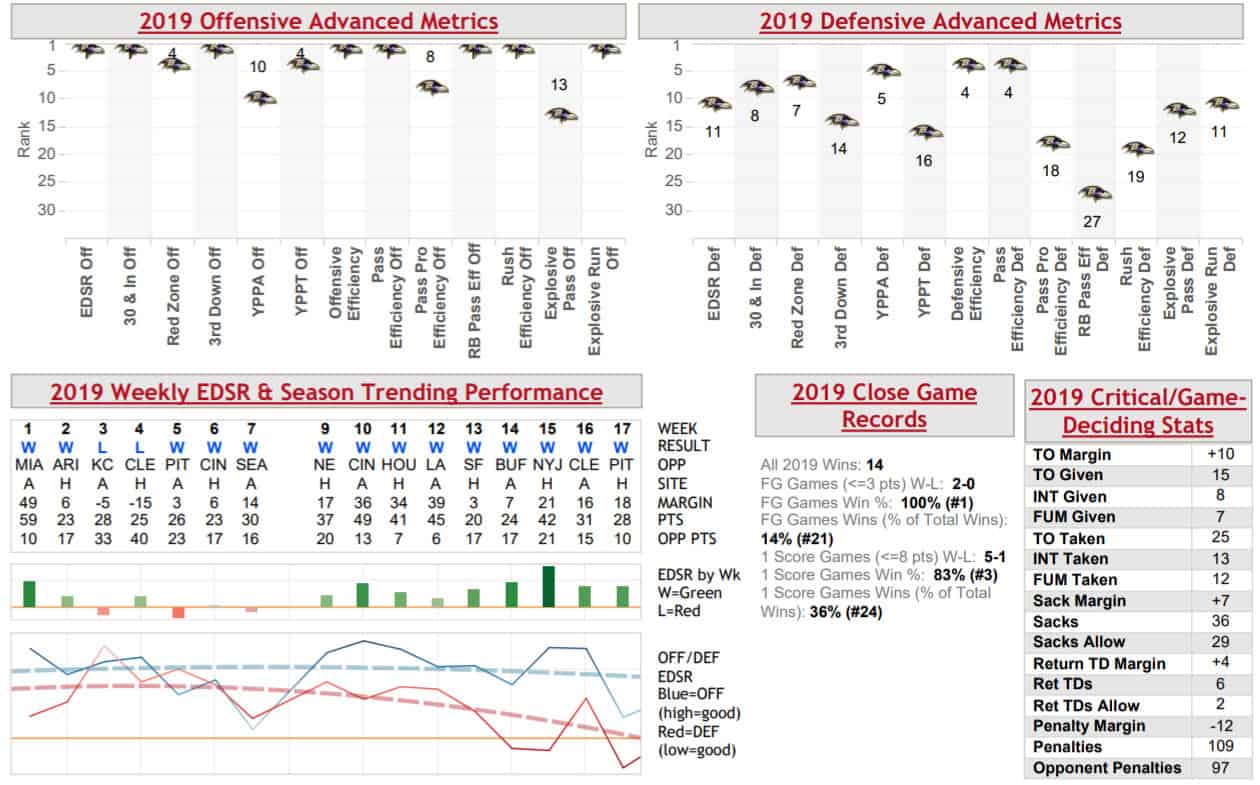
Harbaugh absolutely is not wrong. A quick glance at the completion percentage by depth graphic included in this chapter shows Jackson’s rate on passes beyond 10 yards compared to the league average on early downs needs improvement. And considering how he preforms above average on third down shows reasons to be optimistic this adjustment and improvement will be realized.
The Ravens are fortunate to face the fourth-easiest 2020 schedule after playing the eighth-easiest in 2019. The biggest difference will be in the caliber of defense the Ravens face. Last year they played the 11th-toughest schedule of defenses, including the eighth-toughest pass defenses. But in 2020, they play the third-easiest schedule of defenses including the sixth-easiest pass defenses. If you thought Lamar Jackson’s passing exceeded your expectations in 2019, it could look even better in 2020.
They also have the benefit of an easy start and finish. They open the first five weeks against three teams with projected losing records (Texans, Redskins, and Bengals) and two teams with projected winning records, but both are at home (Browns and Chiefs). These five teams each ranked bottom-10 in run defense in 2019, which plays right into the run-dominant Ravens hands.
They close the season with the league’s easiest schedule starting in Week 12, and their final three opponents (Jaguars, Giants, and Bengals) should do well to propel them to a better playoff seed. The interesting note is their Week 14 game in Cleveland on Monday night is preceded by a Thursday night game at home against Dallas. As such, the Ravens have a great “mini-bye” of 11 rest days to heal and prepare for the Browns.
Keep in mind, with only one team landing a postseason bye, that late mini-bye could be a huge factor. The Ravens have a potential rest advantage over the Chiefs, who will have their bye in Week 10.
If Baltimore can win against Kansas City Week 3, rest up in their Week 8 bye, and their Week 14 mini-bye then land the No. 1 overall seed and be the sole AFC team with a playoff bye, their advantage over the Chiefs would be massive.
Many are predicting regression for the Ravens offense, and while some is certainly possible, it’s hard to imagine a team in better shape to deal with it. This offense was the most efficient offense in the NFL last year and first in many other statistical categories. They face a much easier schedule this season and only have the sole key loss of G Marshal Yanda. They were also fortunate to not lose offensive coordinator Greg Roman to a head coaching job during the offseason.
The defense, which also brings back coordinator Wink Martindale, is the most expensive unit in the NFL and is coming off a season where they ranked first in EDSR defense. The Ravens are in excellent shape to prosper in 2020 and beyond.
Baltimore Ravens 2019 Passing Recap & 2020 Outlook
After improving as a passer every season at Louisville, Lamar Jackson again took a major stride forward over his rookie campaign in his first full season as the starting quarterback. Baltimore fully committed to an offensive approach centered on Jackson’s abilities and it paid off in a big way. On his way to winning the league’s MVP Award, Jackson took the Baltimore passing game from 24th in success rate per play (43%) in 2018 up to ninth in the league in success rate in 2019 (48%). Jackson’s 9.0% touchdown rate should be expected to regress (league average was 4.5% in 2019) in 2020 as well as the overall amount of passing touchdowns from the Ravens, but this passing game is built around his unique skill set and can continue to improve on their 12th ranking in yards per passing play.
2019 Receiving Recap & 2020 Outlook
No team targeted their tight ends at a higher rate than the Ravens (41%) and they were led by Mark Andrews. As a byproduct, Baltimore wideouts combined for 7.3 catches on 11.4 targets per game, both league lows. Despite the low usage, Baltimore wideouts ranked 15th in the league in success rate per target (51%) and 18th in yards per attempt (7.8). 2019 first-round pick Marquise Brown only played 51% of the team snaps as a rookie, but will take on a larger role in the offense. The same should be expected for Miles Boykin, who was selected in the third round a year ago and only played 38% of the snaps. With one of the league’s youngest receiving corps already in place, the team then added Devin Duvernay and James Proche to the unit via the draft this season.
2019 Rushing Recap & 2020 Outlook
Baltimore led the league in yards from scrimmage differential (107.0 per game) on the strength of out-rushing their opponents by 112.6 yards per game. Their 3,296 rushing yards on the season were the most overall by an NFL team in a single season and their 206.0 rushing yards per game were the most by a team in a season since 1976. Baltimore led the league in rushing success rate (55%) and yards per rushing play (5.5 yards). The loss of Marshal Yanda will be felt, but with the dimension this rushing offense has added via Jackson, this should continue to be the league’s most dynamic rushing attack going forward. The Ravens also added J.K. Dobbins, who had the highest rate of shotgun runs and RPO attempts of all backs in this draft class, areas where Baltimore led the league in 2019.

For the complete Baltimore Ravens chapter, including a dozen more visuals & info-graphics, Defensive breakdown and detailed Fantasy football implication — plus the other 31 team chapters — pick up a copy of Warren Sharp’s new ‘2020 Football Preview’ book and use the coupon code “BOOK10” to take $10 off at purchase.


